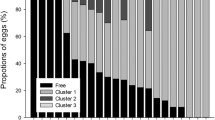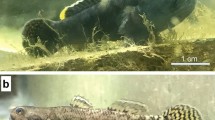Abstract
Clearnose skates, Raja eglanteria, are a common species of skate found seasonally along the Atlantic coast of North America from Cape Cod to mid-Florida and in the Gulf of Mexico from mid-Florida to eastern Texas. Clearnose skates inhabit the west central coast of Florida during winter months, when Gulf temperatures are conducive to mating and egg-laying (approximately 16°C–22°C). Specimens collected during this time will breed in captivity and, if maintained at 20°C, mated females will store sperm and continue to lay fertile eggs for up to six months. With fertile eggs available from day of laying until hatching, the first complete description of batoid elasmobranch embryonic development with a timetable has been established and is presented here. If eggs are maintained at 20°C, appearance and progression of embryonic events proceed over a reproducible timeline. The timeline has been divided into discrete time periods into which developmental events have been grouped. These include cleavage and expansion of the blastodisc (day 1–day 4), embryonic axis and neural tube formation (day 4–day 7), pharyngeal pouches and gill filament development (day 10–day 28), expansion of fins and transition from external filaments to internal gills (week 4–week 7), and epidermal pigmentation and yolk absorption (week 8–week 12). Fully formed offspring hatch after an incubation period of approximately 12 weeks (85 ± 6 days). To examine possible mechanisms of transport and storage of sperm in the reproductive tract of females following copulation, experiments resulting in the first artificial insemination for any elasmobranch fish are described. These experiments provide evidence for functional roles of the alkaline gland, whose secretions stimulate sperm motility and may enhance migration of sperm to the oviducal glands, and the clasper gland, whose secretions may provide nutrition during storage of viable sperm in the oviducal gland.






Similar content being viewed by others
References
Aristotle (343 BC) Thompson translation (1949) Historia animalium. In: The works of Aristotle, vol 4. Clarendon Press, Oxford, pp 485–633
Balfour FM (1878) A monograph on the development of elasmobranch fishes. Macmillan, London
Ballard WW, Mellinger J, Lechenault H (1993) A series of normal stages for development of Scyliorhinus canicula, the lesser spotted dogfish (Chondrichthyes: Scyliorhinidae). J Exp Zool 267:318–336
Beaver BV, Reed W, Leary S et al (2001) 2000 Report of the American Veterinary Medical Association Panel on Euthanasia. J Am Vet Med Assoc 218:669–696
Bilgili SF, Renden JA (1984) Fluorometric determination of avian sperm viability and concentration. Poult Sci 63:2275–2277
Cardullo RA, Baltz JM (1991). Metabolic regulation in mammalian sperm: mitochondrial volume determines sperm length and flagellar beat frequency. Cell Motil Cytoskeleton 19:180–188
Carrier JC, Pratt HL, Castro JI (2004) Reproductive biology of elasmobranchs. In: Carrier JC, Musick JA, Heithaus MR (eds) Biology of sharks and their relatives. CRC Press, Boca Raton
Clark RS (1922) Rays and skates (Raiae). No. 1. Egg-capsules and young. J Mar Biol Assoc UK 12(4):577–643
Clark RS (1927) Rays and skates. No. 2. Description of embryos. J Mar Biol Assoc UK 14(3):661–683
Conrad GW, Paulsen AQ, Luer CA (1994) Embryonic development of the cornea in the eye of the clearnose skate, Raja eglanteria. I. Stromal development in the absence of an endothelium. J Exp Zool 269:263–276
Dean B (1906) Chimaeroid fishes and their development. Publication number 32. Carnegie Institution of Washington, Wilkens-Sheiry Printing Co, Washington, DC
Didier DA, Leclair EE, Vanbuskirk DR (1998) Embryonic staging and external features of development of the chimaeroid fish, Callorhinchus milii (Holocephali, Callorhinchidae). J Morph 236:25–47
Fitz ES Jr, Daiber FC (1963) An Introduction to the biology of Raja eglanteria Bosc 1802 and Raja erinacea Mitchell 1825 as they occur in Delaware Bay. Bull Bing Oceanogr Coll 18:69–96
Gilbert PW, Wood FG Jr (1957) Method of anesthetizing large sharks and rays safely and rapidly. Science 126:212–213
Grabowski GM, Blackburn JG, Lacy ER (1999) Morphology and epithelial ion transport of the alkaline gland in the Atlantic stingray (Dasyatis sabina). Biol Bull 197:82–93
Hamlett WC, Knight DP, Koob T, Jezior M, Luong T, Rozycki T, Brunette N, Hysell MK (1998) Survey of oviducal gland structure and function in elasmobranchs. J Exp Zool 282:399–420
Hamlett WC, Musick JA, Hysell CK, Sever DM (2002) Uterine epithelial-sperm interaction, endometrial cycle and sperm storage in the terminal zone of the oviducal gland in the placental smoothhound, Mustelus canis. J Exp Zool 292:129–144
Huxtable RJ (1992) Physiological actions of taurine. Physiol Rev 72:101–163
Jensen RG (ed) (1995) Handbook of milk composition. Academic Press, San Diego
LaMarca JJ (1964) The functional anatomy of the clasper and clasper gland of the yellow stingray, Urolophus jamaicensis (Cuvier). J Morph 114:303–323
Leigh-Sharpe WH (1920) The comparative morphology of the secondary sexual characters of elasmobranch fishes. Mem I J Morph 34:245–265
Luer CA (1989) Elasmobranchs (sharks, skates and rays) as animal models for biomedical research. In:Woodhead AD (ed) Nonmammalian animal models for biomedical research. CRC Press, Inc., Boca Raton, FL
Luer CA, Gilbert PW (1985) Mating behavior, egg deposition, incubation period, and hatching in the clearnose skate, Raja eglanteria. Env Biol Fish 13(3):161–171
Luer CA, Walsh CJ, Bodine AB, Rodgers RS, Wyffels J (1994) Preliminary biochemical analysis of histotroph secretions from the cownose ray Rhinoptera bonasus and the Atlantic stingray Dasyatis sabina, with observations on the uterine villi from R. bonasus. Paper presented at the 10th Annual Meeting of the American Elasmobranch Society, University of Southern California, Los Angeles, 2–8 June 1994
Maren TH (1967) Special body fluids of the elasmobranchs. In: Gilbert PW, Mathewson RF, Rall DP (eds) Sharks, skates, and rays. The Johns Hopkins Press, Baltimore
Maren TH, Rawls JA, Burger JW, Myers AC (1963) The alkaline (Marshall’s) gland of the skate. Comp Biochem Physiol 10:1–16
Melouk MA (1949) The external features in the development of the Rhinobatidae. Pub Mar Biol Sta Ghardaqa 7:3–98
Metten H (1939) Studies on the reproduction of the dogfish. Phil Trans Roy Soc London 230:217–238
Mosmann TJ (1983) Rapid colorimetric assay for cellular growth: application to proliferation and cytotoxicity assays. J Immunol Meth 65:55–63
Pardue MT, Luer CA, Callendar MG, Chou BR, Sivak JG (1995) The absence of a photopic influence on the refractive development of the embryonic eye of the clearnose skate, Raja eglanteria. Vision Res 35:1675–1678
Perkins FE (1965) Incubation of fall-spawned eggs of the little skate, Raja erinacea (Mitchell). Copeia 1965:114–115
Perry EJ (ed) (1968) The artificial insemination of farm animals. 4th edn., Rutgers University Press, New Brunswick, NJ
Pratt HL Jr (1993) The storage of spermatozoa in the oviducal glands of western North Atlantic sharks. Env Biol Fish 38:139–149
Pratt HL Jr, Tanaka S (1994) Sperm storage in male elasmobranchs: A description and survey. J Morph 219:297–308
Pratt HL Jr, Carrier JC (2001) A review of elasmobranch reproductive behavior with a case study on the nurse shark, Ginglymostoma cirratum. Env Biol Fish 60:157–188
Rasmussen LEL, Hess DL, Luer CA (1999). Alterations in serum steroid concentrations in the clearnose skate, Raja eglanteria: correlations with season and reproductive status. J Exp Zool 284:575–585
Richards SW, Merriman D, Calhoun LH (1963) Studies on the marine resources of southern New England. IX. The biology of the little skate, Raja erinacea Mitchell. Bull Bing Oceanogr Coll 18:5–67
Scammon RE (1911) Normal plates of the development of Squalus acanthias. In: Deibel F (ed) Normentafeln Entwicklungsgeschichte der Wirbeltiere. Gustav Fischer, Jena
Sexton TJ (1979) Preservation of poultry semen—a review. In: Hawk HW (ed) Animal reproduction, Beltsville Symposia in agricultural research, no. 3. Allanheld, Osmun & Co., Montclair NJ, p 159
Sexton T (1982) Beltsville poultry semen extender. 6. Holding turkey semen for six hours at 15°C. Poult Sci 61:1202–1208
Sivak JG, Luer CA (1991) Optical development of the ocular lens of an elasmobranch, Raja eglanteria. Vision Res 31:373-382
Spackman DH, Stein WH, Moore S (1958) Automatic recording apparatus for use in the chromatography of amino acids. Anal Biochem 30:1190–1206
Sukhija PS, Palmquist DL (1988) Rapid method for determination of total fatty acid content and composition of feedstuffs and feces. J Agric Food Chem 36:1202–1206
Uchida S, Toda M, Kamei Y (1990) Reproduction of elasmobranchs in captivity. In: Pratt HL, Gruber SH, Taniuchi T (eds) Elasmobranchs as living resources: Advances in the biology, ecology, systematics, and the status of the fisheries. NOAA Tech. Rep. NMFS 90:211–237
Walsh CJ, Luer CA (2004) Elasmobranch hematology: Identification of cell types and practical applications. In: Smith M, Warmolts D, Thoney D, Hueter R (eds) Elasmobranch husbandry manual: proceedings of the first international Elasmobranch husbandry symposium, 2001, Special publication of the Ohio Biological Survey, Number 16, Columbus, OH
Wourms JP, Bodine AB (1983) Biochemical analysis and cellular origin of uterine histotrophe during early gestation of the viviparous butterfly ray. Amer Zool 23(4):1018
Ziegler HE, Ziegler F (1892) Beitrage zur Entwicklungsgeschichte von Torpedo. Arch Mikr Anat 39:56–102
Acknowledgements
The authors gratefully acknowledge the use of facilities at Mote Marine Laboratory, Sarasota, FL and the Department of Animal and Veterinary Science, Clemson University, Clemson, SC. The authors appreciate the photographic skills of Jose Castro and Patricia Blum for their contributions to some of the figures, and thank Evanne Thies and Rebecca Rodgers for their assistance with the biochemical analyses.
Author information
Authors and Affiliations
Corresponding author
Rights and permissions
About this article
Cite this article
Luer, C.A., Walsh, C.J., Bodine, A.B. et al. Normal embryonic development in the clearnose skate, Raja eglanteria, with experimental observations on artificial insemination. Environ Biol Fish 80, 239–255 (2007). https://doi.org/10.1007/s10641-007-9219-4
Received:
Accepted:
Published:
Issue Date:
DOI: https://doi.org/10.1007/s10641-007-9219-4




